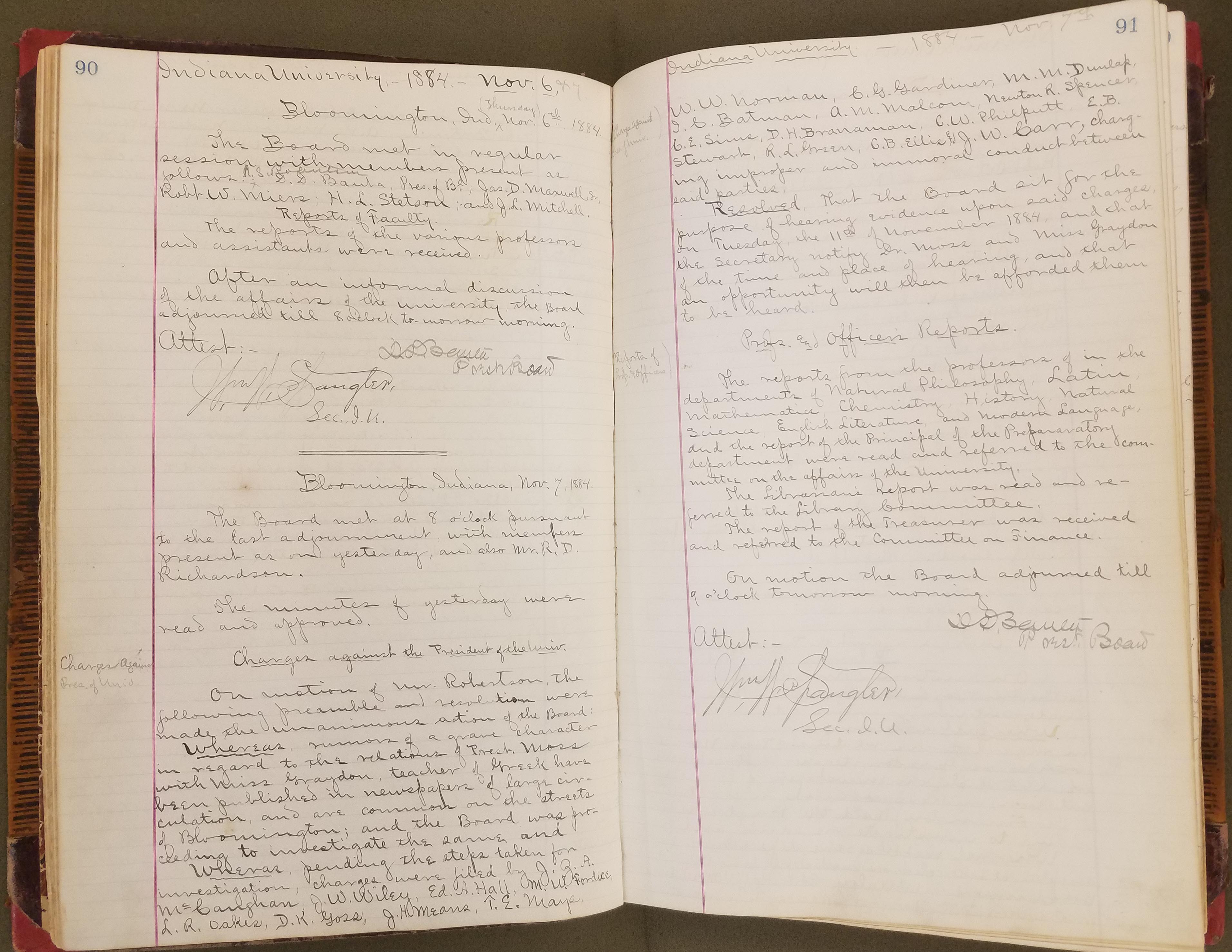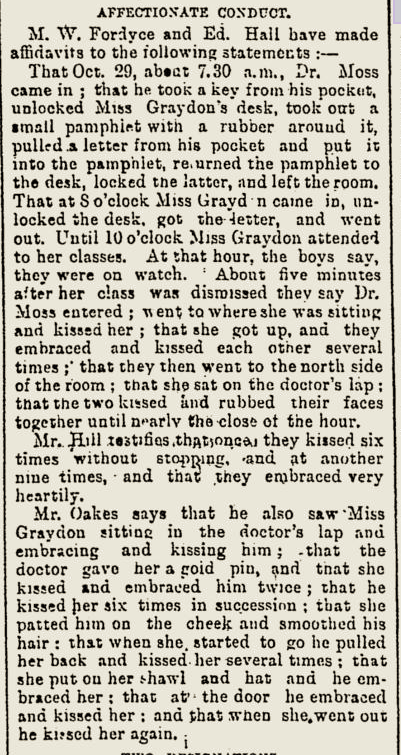Over one hundred years ago a group of six students and one IU staff member made headlines– but not for sports or academic achievement. They were the late nineteenth-century version of a resistance to what they saw as outrageous misconduct and immoral behavior on the part of IU faculty members. Their actions uncovered a scandal in 1884, became campus folklore, could be said to have changed the course of Indiana University’s history, and today are largely forgotten except by those who study IU history.
So, who are they? The Moss Killers.
The Moss Killers consisted of six Indiana University students and an IU janitor:
- James Zwingle Alexander McCaughan, A.B., I.U., 1885
- David Kopp Goss, A.B., I.U., 1887
- Joseph Woods Wiley, Ph.B., I.U. 1886
- Lucian Rhorer Oakes, A.B., I.U., 1885
- Edward A. Hall who died while a student in the university
- Morton William Fordice, B.S., I.U., 1886
- Thomas “Uncle Tommy” Spicer, the janitor.
Together these so-called “Moss Killers” didn’t actually kill anyone (or any fungi), but they managed to uncover and prove a scandal that lead to the resignations of the university president and of a Greek professor. As a result, the University trustees and legislators broke with the past traditions of moralism and classicism and moved toward new educational leadership and an embrace of the intellectual age and academic reform needed for sciences and modern professions that was already present in many other American universities at the time.
Rev. Dr. Lemuel Moss was the sixth president of Indiana University and one of the last in a line of six “Preacher Presidents,” who served the university before Indiana University followed the lead of other American colleges and began to employ presidents more focused on educational philosophy and public responsibility rather than theology or moral instruction. Moss was at the University of Chicago before coming to Indiana University, and he had previously served as the Pastor of a Baptist Church.
As University President at IU, Moss was known to be a popular public speaker and a strict disciplinarian. Between 1880 and 1884 he was also a member of the National Council of Education, vice president of the American Baptist Missionary Union, president of the department of higher education, and a part of the National Education Association. However, his prolific career in higher education was to be interrupted as a result of the Moss Killers.
Miss Katherine Graydon, a young woman in her mid-twenties, began work as a professor of Greek at Indiana University in September of 1883. She was an attractive, charming, and intelligent young woman. The rumors regarding her relationship with Rev. Dr. Moss quickly began soon after the start of her appointment.
After months of suspicion and rumor, the “Moss Killers” formed from a group of undergraduates to find out the facts concerning the relationship between Dr. Moss and Miss Graydon. With the help of Uncle Tommy (the janitor), the six young men used a hand drill to cut a hole in the ceiling above Miss Graydon’s office and the Greek classroom in the University building. They stood watch to see what happened in the room below. And eventually they saw what had been rumored to be true.
The Moss Killers then presented sworn affidavits and charges of “improper and immoral conduct” between the University President and Greek professor to the University Board of Trustees on November 7, 1884.
The Minutes of the Board of Trustees reads:
Charges against the President of the Univ.
On motion of Mr. Robertson, the following preamble and resolution were made, the unanimous action of the Board:
Whereas, rumors of a grave character in regard to the relations of Prest. Moss with Miss Graydon, teacher of Greek have been published in newspapers of large circulation, and are common on the streets of Bloomington; and the Board was proceeding to investigate the same
The digitized and encoded Board of Trustees Minutes can be seen and searched here.

The students told the Trustees that they saw Moss present Miss Graydon with gifts and greet each other in ways that were not at all professional. What was once rumor was now full blown scandal, and an investigation began by the Board of Trustees. They planned to hear evidence on the matter from both Moss and Graydon on Tuesday November 11, 1884.
But, before a hearing or investigation could commence, both Dr. Moss and Miss Graydon presented their resignations abruptly on November 8, 1884.

The story grew and spread, damaging the reputations of Moss and Graydon. Newspapers carried the affair far and wide. The Toronto Daily Mail, Tuesday November 18, 1884 (excerpt seen to the left) ran a detailed story entitled A Grave Scandal: Involving the President of Indiana State University. Well Known to Citizens of Toronto. An Investigation to be Held Upon Charges of Unseemly Conduct.
The social repercussions of the scandal were more problematic for Moss and Graydon than they were for the university. Some say that the newspapers inflated the story before Moss resigned. In any case, the damage had been done.
After her resignation and after a later attempt to rescind her resignation, Katherine Graydon moved to Indianapolis permanently. She was the member of two prominent families, the Merrills and Ketchams, who became extremely defensive of her even when the congregation of her church became involved in the public judgement. In the end however, her defenders won and Miss Graydon became a well respected professor at Butler University and went on to have a long career there.
Dr. Moss was not so lucky. After his resignation he quickly left Bloomington. He spent some time in Chicago at a manufacturing firm, then worked editing a religious magazine, later spent time in Philadelphia, and was also a professor of Christian sociology at Bucknell. Dr. Moss died in New York in 1904 at 75 years old.
The Moss Killers, the scandal and affair they uncovered, and Dr. Moss’s resignation created some chaos at Indiana University. The role of president was filled temporarily by Elisha Ballantine, much to everyone’s approval. The University then went on to search for the right new president. The Board of Trustees needed to keep up with the times, and they needed a university president who could lead Indiana University into the new age of American intellectualism and science. The Moss Killers may not have killed anyone really, but their actions damaged one man’s reputation permanently, and ushered in a new era of leadership at Indiana University.
Leave a Reply